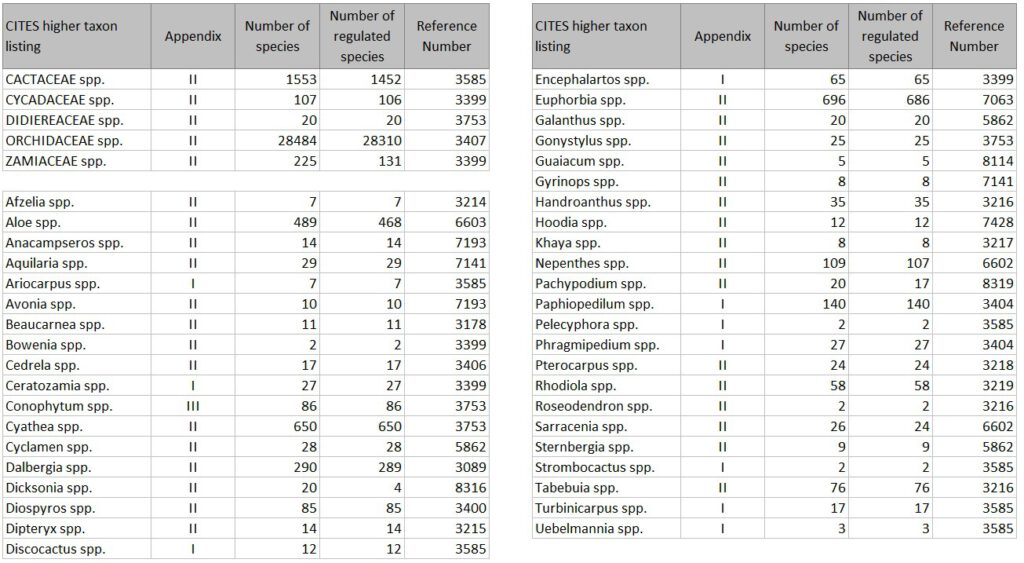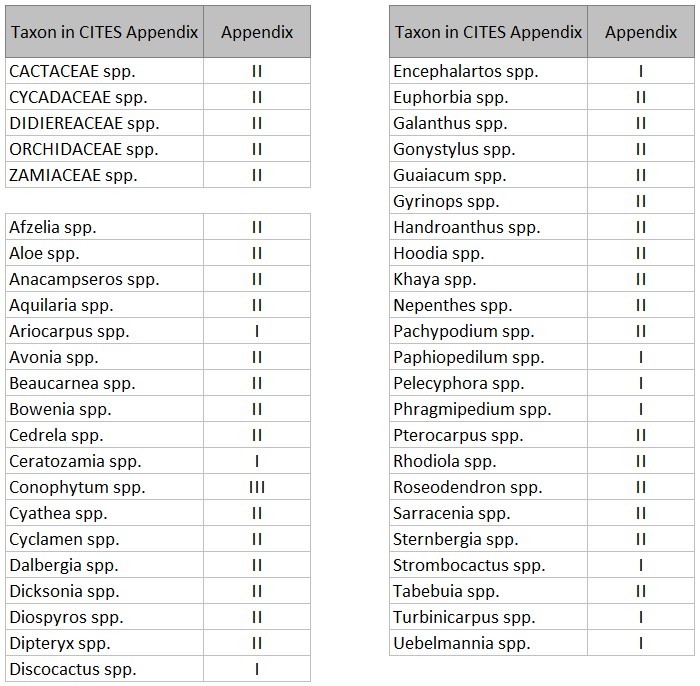At the core of the Convention on International Trade in Endangered Species of Wild Fauna and Flora (CITES) are the three CITES Appendices, Appendix I, II and III. This webpage answers the question: How many plant species are included in the three CITES Appendices?
It is not possible to simply count the total number of species in the CITES Appendices, because many listings have been made at genus or even family level, whose species are not listed individually in the Appendices.
Number of species in the CITES Appendices
Table 1 outlines the number of plant species in the three CITES Appendices.
| CITES Appendix | Number of plant species |
| I | 397 |
| II | 32,831 |
| III | 113 |
The published list of entirely CITES-listed plant families and genera with species numbers and explanatory text helps to understand the basis for the current calculations in Table 1.
In addition, the webpage‚ How Many Medicinal Plants are Included in the CITES Appendices‚ presents a breakdown of CITES listed plants based on their use, such as ornamentals, tree species used for timber and medicinal plants.
Difficulties encountered in calculating species numbers in the CITES Appendices!
The figures and their background presented here are unique. The CITES webpage only presents a total number of species and subspecies for each Appendix, while the World Conservation Monitoring Centre (UNEP-WCMC) as the official host of the CITES Checklist does not provide a numerical breakdown.
(i) Listing of whole families and genera
While the majority of taxa are listed in the Appendices at species level (including 4 subspecies and 1 variety), a considerable number are at higher taxon level as genus or family. Table 2 outlines family and genus level listings.
(ii) Exclusion of species from a listed family or genus
In a number of higher taxon listings some species are explicitly excluded from the listing; for example:
- In the listing of Aloe spp. in Appendix II, the species Aloe vera is excluded.
- In several higher taxon listings in Appendix II, a number of species are listed in Appendix I. One example: The species of the genus Pachypodium spp. are included in Appendix II, but three species have been included in Appendix I: P. ambongense, P. baronii, and P. decaryi. This means they do not count in the number of Pachypodium species in Appendix II.
- The listing of Euphorbia spp. in Appendix II is amended by „succulent species only“.
- Other higher taxons listings are amended to restrict the listing to certain populations, e.g. the listing of Dicksonia spp. in Appendix III is restricted to „Only the populations of the Americas; no other population is included in the Appendices“.
(iii) Split listing on species and subspecies level
Four taxa are included in the Appendices as subspecies: Echinocereus ferreirianus subsp. lindsayorum, Sclerocactus brevihamatus subsp. tobuschii, Sarracenia rubra subsp. alabamensis, and Sarracenia rubra subsp. jonesii. They are all in Appendix I and their family/ genus is listed in Appendix II.
This has consequences in the calculations as the following illustrates: The CITES Carnivorous Plant Checklist accepts five subspecies of Sarracenia rubra. Since Sarracenia spp. is included in Appendix II this means that two above mentioned subspecies are in Appendix I and the remaining three are in Appendix II. This makes counting difficult: One has to distinguish between counting on the species level (in our example 1 species) or on the subspecies level (5 infraspecific taxa in our example).
Determining the number of species in the genus and family listings
To overcome the obstacles highlighted above, the following approach was taken:
(i) Split listing on species and subspecies level
Split listings are counted here at species level only and not on the level of infraspecific taxa (subspecies or variety). The only listing of a taxon at variety rank is Magnolia liliifera var. obovata in Appendix III.
(ii) Listing of whole families and genera
Authoritative taxonomic works were consulted to determine the number of species in the family and genus listings in the CITES Appendices. Where available the standard references adopted by the Conference of the Parties [Res.Conf. 12.11 (Ref.CoP 19)] were used. Where no such CITES standard was available, other reliable taxonomic sources were chosen.
(iii) Exclusion of species from a listed family or genus
Table 3 distinguishes between the overall number of species (based on taxonomic references) in a genus or family and the number of species regulated by CITES. The number of regulated species is often lower due to exclusion of certain species (see above). The references identified by the Reference Number in Table 3 can be found here.

_____________________________
by Uwe Schippmann, 19.2.2023

